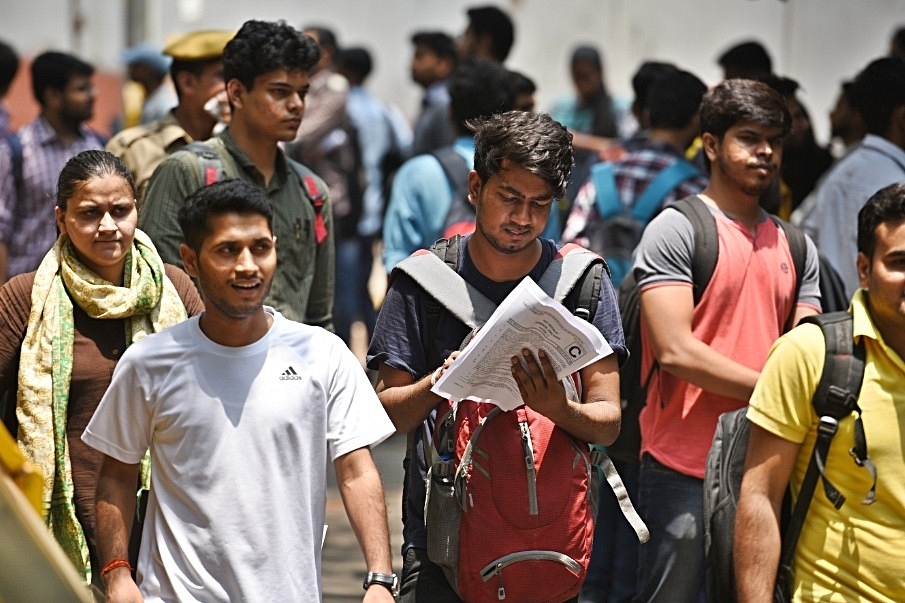Insta
UPSC Civil Services Mains 2019: IAS Aspirants Can Maximise Marks With Correct Paper-Attempting Strategy

More than eight lakh students appeared for the UPSC Civil Services 2019 exam (Raj K Raj/Hindustan Times via Getty Images)
As the UPSC Civil Services Mains exam draws closer, it is important for aspirants to maintain a good time-table and practice regime. The aspirants need to prioritise between different subjects, answer writing practice and reading new material.
Since less than a month remains in the exam, the aspirants should focus more on practising full-length papers, at least one everyday. This will help build the speed as well as the habit of being able to think and structure the thoughts quickly. If one goes in the exam without answer-writing practice, it is highly likely that even if one is well-read, he won’t be able to perform well.
The exam involves two papers of three hours each with small lunch-break in between. So, candidates are required to write continuously at a fast pace for six hours. This cannot be accomplished without practice.
This time is not for starting new material, books or making new notes. Students should have faith in themselves and revise the material they have already studied. In case, they have skipped substantial portions of a subject (or a subject altogether), they should pick the most concise and structured source to read it quickly. Hand-written notes of coaching classes should come handy.
Strategy to attempt Mains papers
Ultimately, it comes down to what one is able to write in the paper. The students should aim to attempt all the questions instead of trying to write lesser number of questions ‘perfectly’. At most, two questions - the ones that the aspirant knows nothing about, can be skipped. The goal should remain to attempt as many questions as possible.
The paper is divided into two kinds of questions - 10 marks and 15 marks. Optional subjects have 20-marks questions too. Students must stick to the word limit. The answer should consist of three parts - the introduction, main body, and conclusion. If the second one is lengthy, the other two can be done briefly. This minimum structure should be visible in every answer, whether written in paragraphs or point wise.
Making comparison tables, figures, point-wise writing etc can save you space, therefore should be incorporated in the answer. However, these shouldn’t be redundant, as in, they shouldn’t just repeat what the text says, else they will just waste time.
One way to attempt the paper to finish it completely, is to finish a few 10 markers and then a few 15 markers. These must be the ones that the candidate is most confident in. This way, you have given your best in these questions where you have the capability.
Next, candidates should finish 10-markers which are less well prepared, or require more thinking. Here, the candidates should leave some space for the introduction and conclusion, and write the main body.
The candidate should then proceed to complete remaining 20 mark-questions. At the end, the candidate should finish the introduction and conclusion part of the above questions.
Whenever ready to write an answer, the candidate should think what would he be able to write if the word limit was 50. This way, the candidate will know what are the important points and keywords not to be missed. She can also quickly jot these down in the rough.
Support Swarajya's 50 Ground Reports Project & Sponsor A Story
Every general election Swarajya does a 50 ground reports project.
Aimed only at serious readers and those who appreciate the nuances of political undercurrents, the project provides a sense of India's electoral landscape. As you know, these reports are produced after considerable investment of travel, time and effort on the ground.
This time too we've kicked off the project in style and have covered over 30 constituencies already. If you're someone who appreciates such work and have enjoyed our coverage please consider sponsoring a ground report for just Rs 2999 to Rs 19,999 - it goes a long way in helping us produce more quality reportage.
You can also back this project by becoming a subscriber for as little as Rs 999 - so do click on this links and choose a plan that suits you and back us.
Click below to contribute.
Latest